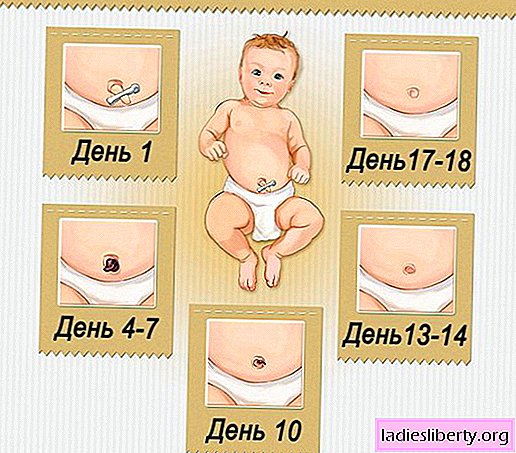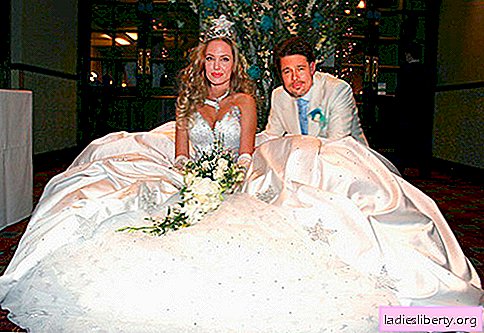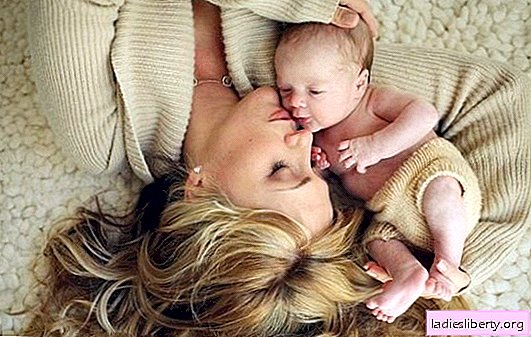
The reliable way by which a caring parent passed on everything necessary for her baby for so long breaks off in the first minutes of the baby's birth. From now on, he will eat on his own and get rid of unnecessary substances, and in place of the umbilical cord there will remain an eternal symbol of unity with his mother - the navel.
Navel in a newborn
A shiny bluish cord, 40 to 70 centimeters long, twisted in a spiral and attached at one end to the baby’s tummy and the other to the placenta. It looks like an umbilical cord through which a long nine months old baby, comfortably settled in his mother’s stomach, got everything necessary for his life. Immediately after the birth of a baby, you can see how she pulsates, continuing to perform her important and useful functions. However, the doctor literally immediately puts on her a special clip or bracket and cuts off the “communication channel” that has become unnecessary. The movement of blood stops, and instead of the umbilical cord there is a “tail”, about two centimeters long, which will dry up and disappear after a while. It is important to know that early cutting of the umbilical cord is fraught with the onset of anemia in the baby, so the doctor expects about 5 minutes until the ripple is over. Some maternity hospitals use a slightly different technique. Instead of waiting until the rest of the umbilical cord falls off on its own, it is removed on the second day after delivery with scissors or a blade, and a bandage is applied to the wound.
It is extremely useful to know and follow simple rules that will help in the speedy healing of the navel:
- air baths - not only an excellent tool for drying the wound, but also helps to avoid diaper rash. It should begin with 2-3 minutes two to three times a day, gradually bringing the duration of the procedure to 15-20 minutes;
- Do not allow the diaper to rub against the umbilical cord, it is better to fix the fastener a little lower;
- Do not listen to the advice of neighboring grandmothers and, for a beautiful navel shape, apply a coin or patch to it - the result may not please;
- the delicate skin of the baby should be in contact only with natural materials;
- when processing a wound, one should know that the navel does not contain nerve endings, so mother’s actions do not cause pain to her baby.
Processing a newborn's navel
While the young mother and the baby are in the hospital, the navel is constantly being treated with antiseptic drugs, regardless of which method of umbilical cord removal was used. Most often, manganese or hydrogen peroxide is used for these purposes. Usually, on the fifth day, the dried tip of the umbilical cord disappears, but the wound remaining in its place must be continued to be treated until it is completely healed. Drying gradually, it becomes covered with a dense crust. The average healing time is as follows:
- the first five days - there is a gradual drying of the remainder of the umbilical cord;
- the fourth or fifth day - the finally dried up “tail” falls off independently;
- 1-3 weeks - the wound gradually heals;
- 4th week - final healing.
If individual terms differ from these indicators by more than three days, it is advisable to consult a pediatrician.
After discharge home, treatment should continue. This usually takes about 10 days, although if surgical removal has been performed, faster healing is possible. It is best to treat the navel after bathing, when the crust becomes softer. The first month, before the wound has healed, it is advisable to pour only boiled water into the baby’s bath. Adding a decoction of a string to it does not at all guarantee that the infection will not get into the wound. The processing process proceeds as follows:
1. After taking a bath, gently pat the baby's body with a towel. Using a pipette, drop hydrogen peroxide on a baby’s navel and wait a bit.
Attention! Hydrogen peroxide is bought only in a pharmacy in the finished form. Pay attention to the expiration date!
2. After the solution has stopped foaming and the crust has become soft, you need to push the skin in the area of the navel and carefully remove fragments of the lagging crust with cotton buds. In no case should you try to penetrate too deeply or tear off stuck pieces, at one time they will fall off on their own.
3. After drying the wound with a gauze cloth, grease it with green.
Many pediatricians are extremely negative about this tool, and in European countries they do not even suggest that green can be used in such cases. Mom is quite capable of making a decision on the use of a solution of diamond greens, at her request the doctor can prescribe another antiseptic.
When treating a wound, you should pay attention to how hydrogen peroxide behaves. If during the next procedure the mother does not observe her foaming, the wound has healed safely.
A navel in a newborn is bleeding what to do
In the first days after the removal of the umbilical cord, small spotting is quite possible. However, if the healing process is too long, bleeding does not stop, and sometimes occurs at the healing stage, you should take a closer look at the anomaly and respond properly. Quite common causes in which the umbilical wound can bleed are:
1. The lack of air does not allow the wound to dry out successfully.
2. An umbilical cord that is too wide can cause a deep and wide wound, the healing process of which requires a longer time.
3. The constant friction of the diaper.
4. Incorrect trimming.
5. Putting the baby on the stomach, (doctors recommend practicing this only after three months).
6. Too active actions of the mother during the processing of the navel, new tissues do not have time to form properly.
7. A tiny piece of fleece that gets into the wound can cause inflammation.
8. Weakened immunity.
9. Umbilical hernia.
Attention! Strong bleeding, unpleasant odor and signs of inflammation of the surrounding tissues are a reason for immediately contacting a doctor!
If spotting is associated with a violation of the integrity of the healing crust or irregular treatment, it is sufficient to carefully treat the wound with the method described above and provide free access to air. In the case of a foreign body in the wound, the formation of a hernia or a weakened immunity, the help of a doctor will be needed. If blood continues to be released for three weeks, you should pay attention to the presence of additional signs:
- swelling in the navel and local temperature increase;
- purulent discharge and putrefactive odor;
- unusual protrusion of the navel, especially with tension, and insufficient muscle contraction in the umbilical ring;
- increased body temperature.
If they are found, you can’t do without a visit to the doctor. He will examine the baby and prescribe the necessary treatment.
If your belly button gets wet
The main causes of a weeping navel are a violation of simple hygiene rules. The use of non-sterile material in the treatment of wounds, bathing in unboiled water, not properly ironed clothing crumbs and, no matter how corny, dirty hands. Wound infection slows healing and causes fluid to accumulate in it. Humidity of the navel is accompanied by redness of the skin around it, swelling, the appearance of yellow purulent crusts, soreness and hot skin at the site of inflammation.
Unpleasant symptoms should serve as a good reason for contacting a doctor who will choose the most suitable medication. The daily number of wound treatments will have to be increased, sometimes it is required to carry out them every two hours. The procedure itself is significantly different from the usual one - it will be necessary to refuse hydrogen peroxide, and instead use Baneocin in powder form, streptocide, potassium permanganate solution, Xenoform, alcohol solution and others.
The doctor will choose the most effective drug in this case, the mother will only need to strictly fulfill his appointment. Before using the recommended medications, the wound must be cleaned of pus and fluid, and only then apply the necessary medicine. Particular attention should be paid to the free access of air; in diapers, it is desirable to make a recess for the navel. Ignoring the doctor’s advice, you can get quite formidable complications:
- sepsis - blood poisoning;
- omphalitis - infectious inflammation of the umbilical wound;
- peritonitis - inflammation of the abdominal cavity, and some others.
The independent use of drugs not prescribed by the doctor and the use of unconventional methods of treatment without his consent is fraught with serious troubles for the tiny man.
Attention! It is impossible to stick a wound with an adhesive plaster, it threatens the rapid multiplication of microorganisms!
What should a healed navel of a newborn look like?
Ideally, in two months (and often earlier), the baby becomes the owner of a neat and pretty navel. This is a fairly wide and flat leathery hem located in the middle of the umbilical ring. It does not differ in color from the surrounding tissues, does not shine, and is not covered with moisture.

Sometimes in the area of the navel, a protrusion can be noticed, which increases with crying. Do not worry - this is an umbilical hernia, which does not require special treatment and will pass when the abdominal muscles are strong enough.
Sometimes the baby’s formed and healed navel protrudes too much above the surface of the body, resembling a stump. It’s all to blame for the crawling of nearby skin on him, and they call him “skin”. This can not be considered a drawback, nature has awarded the baby with such a navel. Gradually, as it grows, it will not become so noticeable, so it’s not worth worrying.











